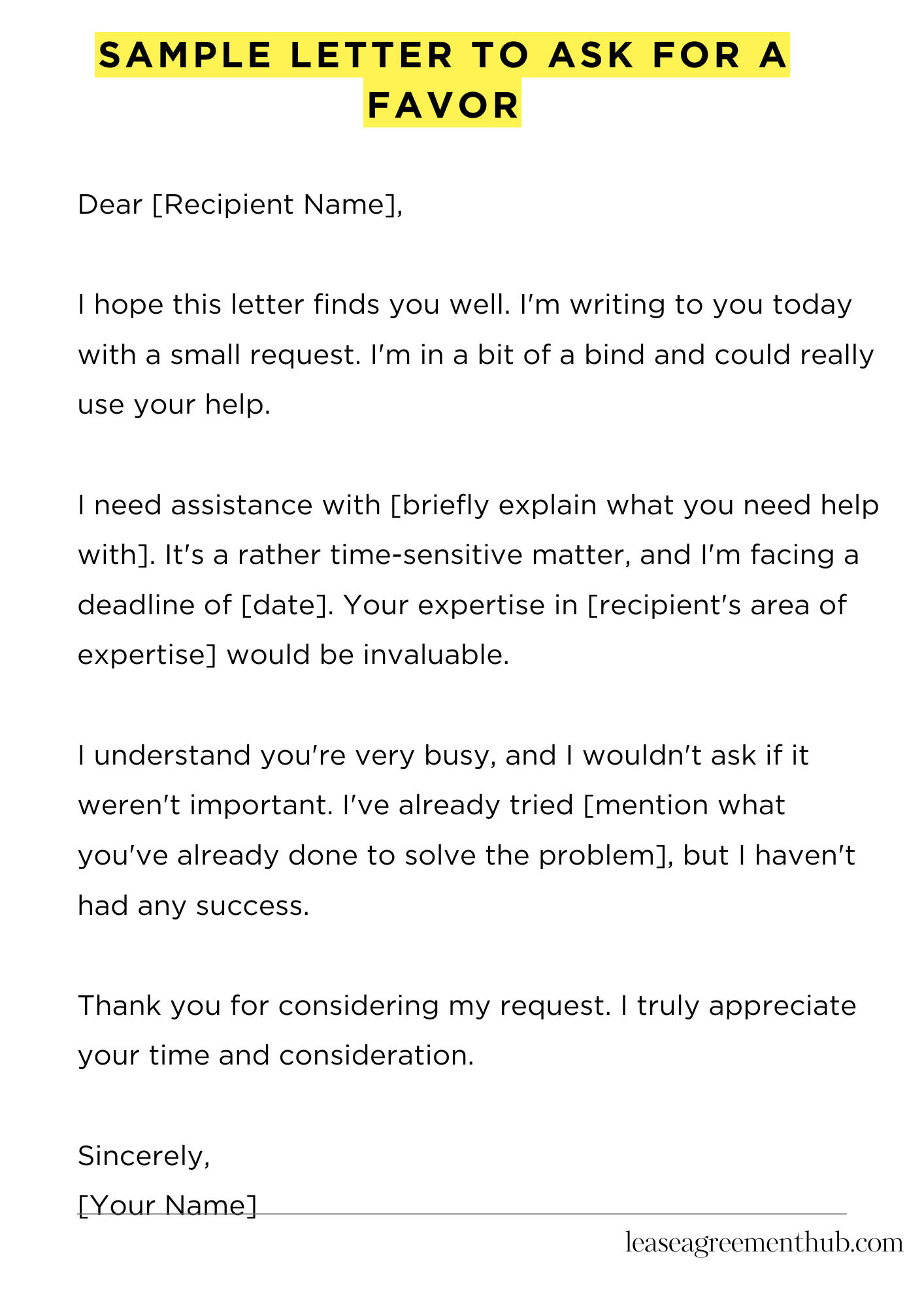Need to ask someone a favor? A letter can be a great way to do it. It shows respect and clearly states your request.
This article gives you examples. We’ll share different letter templates. These will help you write your own favor request.
Use our samples as a guide. They make writing easier. You’ll find it simple to adapt them to your needs.
Sample Letter to Ask for a Favor
[Your Name]
[Your Address]
[Your Phone Number]
[Your Email Address]
[Date]
[Recipient Name]
[Recipient Address]
Dear [Recipient Name],
I hope this letter finds you well. I’m writing to you today with a small request. I’m in a bit of a bind and could really use your help.
I need assistance with [briefly explain what you need help with]. It’s a rather time-sensitive matter, and I’m facing a deadline of [date]. Your expertise in [recipient’s area of expertise] would be invaluable.
I understand you’re very busy, and I wouldn’t ask if it weren’t important. I’ve already tried [mention what you’ve already done to solve the problem], but I haven’t had any success. Your assistance would be a tremendous help in resolving this situation.
I’m available to discuss this further at your convenience. Please let me know if you’re able to assist, and if so, what would be the best way to proceed. Thank you for considering my request. I truly appreciate your time and consideration.
Sincerely,
[Your Name]

How to Write a Sample Letter to Ask for a Favor
Understanding the Nuances of Favor-Seeking Correspondence
Crafting a compelling request for a favor requires finesse. It’s not merely about stating your need; it’s about building a persuasive narrative. Consider your relationship with the recipient. A close friend will warrant a less formal approach than, say, a business acquaintance. The key is judicious calibration of your tone and language to resonate with your audience.
Structuring Your Epistolary Plea: A Pragmatic Approach
Begin with a warm, personalized salutation. Avoid generic greetings. Then, succinctly state your request. Clarity is paramount; obfuscation is your enemy. Following your request, provide ample context, elucidating the reasons behind your plea. A well-reasoned justification significantly enhances the likelihood of a positive response. Conclude with a sincere expression of gratitude, regardless of the outcome.
The Salutation: Setting the Right Tone
The salutation sets the stage for your entire letter. A formal request might begin with “Dear Mr./Ms. [Last Name],” while a letter to a close friend could start with a more familiar “Dearest [Name]”. Think carefully about your relationship with the recipient and choose a salutation that reflects that dynamic appropriately. The salutation is your overture; let it be harmonious.
Crafting a Compelling Narrative: The Art of Persuasion
Don’t simply state your request; weave a narrative. Explain the situation clearly, concisely, and convincingly. Highlight the significance of the favor to you and, if relevant, to the recipient. Emphasize mutual benefit whenever possible. Remember, a compelling narrative transcends mere information; it evokes empathy and understanding.
The Body: Articulating Your Needs with Precision
The body of the letter is where you meticulously detail your request. Be specific about what you need and what you can offer in return. This reciprocal element is crucial. It demonstrates your understanding that favors are rarely unidirectional transactions. Avoid hyperbole; let your genuine need resonate without embellishment.
Expressing Gratitude: A Mark of Politeness and Respect
Regardless of whether your request is granted, express your sincere gratitude. A heartfelt thank you underscores your appreciation for the recipient’s time and consideration. This concluding flourish leaves a lasting impression of professionalism and respect. It cements your relationship, paving the way for future interactions.
Proofreading: The Cornerstone of Effective Communication
Before dispatching your letter, meticulously proofread it for grammatical errors and typos. A letter riddled with errors undermines your credibility and diminishes the impact of your request. Consider having a fresh pair of eyes review your work before sending. This final step ensures that your message is conveyed with the utmost clarity and professionalism.
FAQs about sample letter to asking for a favor
What information should I include in a letter asking for a favor?
Your letter should clearly state the favor you’re requesting, provide context and background information for your request, explain why you’re asking this specific person, and express your gratitude in advance. Be sure to also include your contact information.
How formal should my tone be when asking for a favor in a letter?
The formality of your tone should depend on your relationship with the recipient. If you are writing to a close friend or family member, a more informal tone is appropriate. If you are writing to a colleague or someone you don’t know well, a more formal tone is necessary.
What is the best way to structure a letter asking for a favor?
A typical structure includes a polite opening, a clear explanation of the favor, the reasons behind your request, a statement of gratitude, and a closing with your contact information. Keep it concise and easy to read.
How can I make my request sound less demanding?
Phrase your request as a polite question rather than a demand. Use words like “would you be willing to,” “I would be grateful if,” or “I was hoping you might be able to.” Emphasize the value of their assistance to you.
What should I do if my request is denied?
Respond gracefully and respectfully, thanking the person for their time and consideration. Accept their decision without pressure or resentment.
Related: